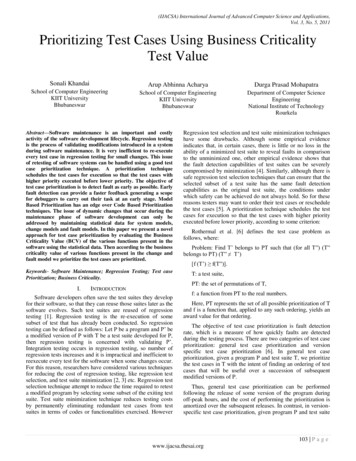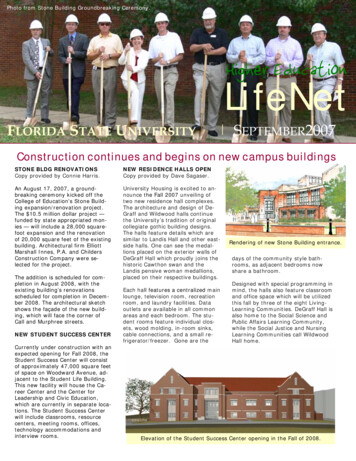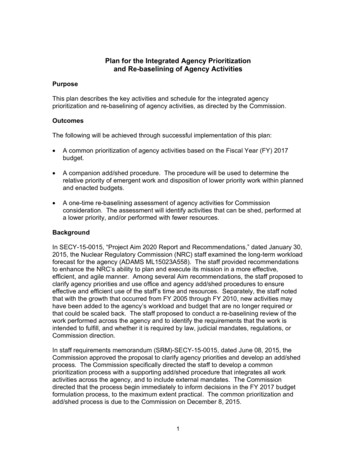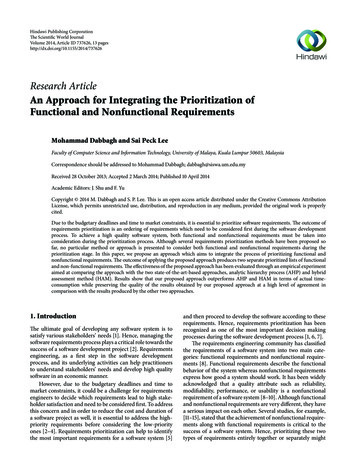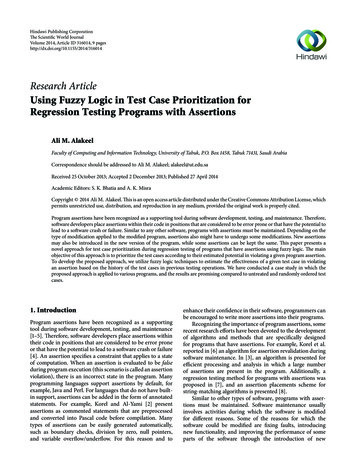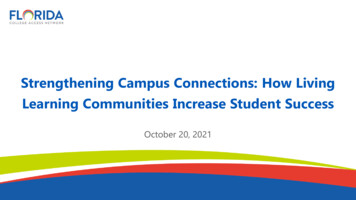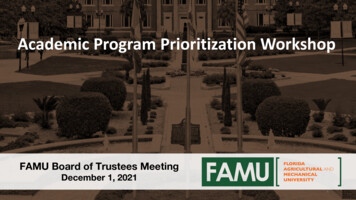
Transcription
Academic Program Prioritization WorkshopFAMU Board of Trustees MeetingDecember 1, 20211
Workshop AgendaTimeTopicLeadDetail10 minWelcome andBOT PerspectiveTrusteeWashington Board of Trustees’ perspective Purpose of workshop15 minProjectOverviewDr. Edington Agenda and introductions Objectives of academic program prioritization Project timeline Are the objectives of the study appropriate?50 minAcademicProgramPrioritizationModel andMetricsDr. Kincey Best practices observed from other institutionsDiscussion of model inputsDiscussion of model weightsDiscussion of program pathways and associatedoutcomes Review subset of program rankings by selectmetrics Do the proposed inputs and weights align with the SUS10 minBreak15 minPotential NewPrograms20 minClose andQ&ADr. KinceyDr. Edington Overview of filtering and assessment process Review of shortlisted candidates Next steps and timeline for existing and potentialnew programs Q&A sessionFacilitation questionsand the Board’s strategic priorities? Do the program pathways align with your understandingof where investment and/or rationalization is merited? Based on workforce and student demand, do you believeadditional programs are needed at FAMU? What additional programs should we consider? Are the next steps and timelines appropriate? What are your thoughts about the study? How might the results of the study be used to strengthenprograms at FAMU?
Board of Trustees’ PerspectiveStrategic PrioritiesStudent SuccessWorkshop PurposeComprehensive Overview of ModelFaculty ExcellenceSolicit BOT Feedback and PerspectivesWorkforce AlignmentReview of Next Steps and DeliverablesOperational EfficiencyStrategic Allocation ofResources
Introductions and AcknowledgementsInternal TeamSundra Kincey, Assistant VP of Program QualityCrystal Bryant, Coordinator for Academic Programming and AccountabilityBrandi Newkirk, Director for Accreditation and PlanningPartnership for Education AdvancementJames W. Runcie, PresidentRobin S. Minor, Senior VP for InstitutionalPartnerships and Risk Management
Facilitation questionsAre the objectives of the academic program prioritization study appropriate?
Academic Program PrioritizationDefinitionWhy are we doing this? Academic program prioritization is theprocess used by an academic institution toassess and prioritize programs,departments, and services in order toensure the strategic allocation of currentuniversity funding and resources. Shape the existing and academic future ofacademic programming at FAMU Use a data-driven process to prioritizeacademic programs Identify opportunities for programenhancements Identify potential areas for resource allocation Academic program prioritization ensuresthat critical decisions regarding academicprograms and resource allocation arealigned with strategic goals and institutionalmission.
Project TimelinePhase I (Completed June 30, 2021) Develop a model and conduct a comprehensive assessment of academic programofferings against workforce needs, demand, productivity and institutional prioritiesPhase II (December 30, 2021) Develop a ranked list of programs based on the evaluation methodology Incorporate recommendations and enhancements from external partners Solicit feedback from academic programs and TrusteesPhase III (June 30, 2022) Solicit additional feedback from academic programs and Trustees Finalize decisions on enhancement of resource allocations with priorities Identify shortlist of high potential new programs assessed against prioritization framework Incorporate analysis tools developed by external partner (HelioCampus) Plans for stakeholder syndication
Tenets Guiding the ProcessTransparencyAcademic t success and social mobilityBuilding on FAMU’s strengthsUse of Internal and ExternalStakeholders
Observations from peer institution program reviewsNOT EXHAUSTIVEMetrics1 Alignment with State, Board of Trustees, UniversityPriorities External and internal demando labor market projectionso enrollment and degrees awardedo student credits generated Quality of program outcomeso graduation rateso employer satisfaction Revenue and other resources generatedo tuitiono faculty contracts and grants1 Review of secondary literature and relevant case studies on strategic program review at U.S. universities and collegesSource: literature review, case studies Costs and other expenseso cost per full-time studento allocated institutional support Impact, justification, and overall essentialityo contribution to institutional reputation andmission Opportunity analysiso potential net revenueso opportunity to realign or strengthen programso potential for new programs
Facilitation questionsDo the proposed inputs and weights align with the SUS andthe Board’s strategic priorities?
Academic Program Prioritization Model MetricsMetric categoriesMetric1Demand andsatisfaction (20%)Workforce supply and demand (15%) FETPIP % employedFlorida Department of Economic Opportunity – FL occupational growthBureau of Labor Statistics – projected national occupational growthMedian wages – FETPIP and Dept. of EducationStudent satisfaction (5%) FAMU Exit Survey percent already accepted a jobFAMU Exit Survey percent confident in finding a jobFAMU Exit Survey percent very confident in finding a jobFAMU Exit Survey percent very satisfied with value of degreeFAMU Exit Survey percent that would recommend degree to othersAcademic program productivity &effectiveness (20%) Degree productivityEnrollment (by degree level)Evidence of improvement in student learning and outcomes as a result of assessment program outcomesFour-year graduation rate (Undergraduate) and Time to degree (Graduate)Retention/ Academic progress ratesGraduation with excess credit hoursCost effectiveness (per SCH) (10%) Cost per credit hour by degree level (2-digit from expenditure analysis)Student credit hours generated from expenditure analysisResearch productivity (15%) Sponsored researchScholarly worksFundraising (5%) University advancement initiatives, fundraising, and alumni givingProgram financial viability (10%) Gross margin (revenue generated by program - minus expenditure divided by revenue) at the 2-digit CIP level from expenditure analysisCompetitive landscape (5%) Diverse Issues Rankings degree production of African AmericansBOG areas of strategic emphasis (5%) Program listed on BOG Areas of Strategic EmphasisBOG low productivity (5%) Number years program listed on BOG Low ProductivityMission critical – historic mission (5%) Historical mission - programs defined as agriculture, education, African-American studies, engineeringFAMU stakeholders’ perceptions survey - college/school familiarityFAMU stakeholders’ perceptions survey - Importance of degree offerings to the success of FAMUPell Grant eligibilityOut-of-state and in-state student percentagesSUS market shareAcademic programperformance andcompetitiveness(65%)Mission critical andSUS programalignment (15%)The academic program prioritization model assesses programs on 30 metrics across three areas of focus for FAMU1.Additional metricsAreas of focusMetrics are evenly weighted within their metric categories
Demand and satisfaction (20%)Metric categoriesWorkforce supplyand demand (15%)Studentsatisfaction (5%)MetricDescriptionFETPIP % employedData on former students who have graduated from a publiceducation or training program within the State of FloridaFlorida Department of Economic Opportunity – FLoccupational growthEmployment projections for the State of Florida overan 8-year periodBureau of Labor Statistics – projected national occupationalgrowthEmployment projections nationally within the U.S.over a 10-year periodMedian wages – FETPIP and Dept. of EducationMedian annual earnings of students 1 year aftergraduationFAMU Exit Survey percent already accepted a jobSelf-reported data of students prior to graduationFAMU Exit Survey percent confident in finding a jobSelf-reported data of students prior to graduationFAMU Exit Survey percent very confident in finding a jobSelf-reported data of students prior to graduationFAMU Exit Survey percent very satisfied with value of degreeSelf-reported data of students prior to graduationFAMU Exit Survey percent that would recommend degree toothersSelf-reported data of students prior to graduation
Academic program performance and competitiveness (65%)Metric categoriesMetricDescriptionDegree productivityAverage number of degrees awarded over a 5-year periodEnrollment (by degree level)Average number of students enrolled over a 5-year periodEvidence of improvement in student learning and outcomes as a result ofassessment program outcomesAnnual university assessment scorecard ratingFour-year graduation rate (Undergraduate) and Time to degree(Graduate)4-year graduation rate based on Major Exiting (Undergraduate)and time to degree (Graduate)Retention/ Academic progress ratesUndergraduate: 2nd-year retention with GPA 2.0 based onMajor EnteringGraduation with excess credit hours% of a program’s students that graduate with excess credit hoursCost effectiveness(per SCH) (10%)Cost per credit hour by degree level (2-digit from expenditure analysis)Cost per credit hour by program at 2-digit CIP compared to SUSStudent credit hours generated from expenditure analysisCredit hours generated by program on a 5-year averageResearchproductivity (15%)Sponsored researchExpenditures generated through contracts and grants w/i last 5 yrs.Scholarly worksScholarly research and creative activity by faculty w/i last 5 yrs.Fundraising (5%)University advancement initiatives, fundraising, and alumni givingFundraising activities and/or alumni giving by college and schoolProgram financialviability (10%)Gross marginRevenue generated by program - minus expenditure divided byrevenue at the 2-digit CIP level from expenditure analysisCompetitivelandscape (5%)Diverse Issues Rankings degree production of African AmericansAcademic program rankings in Diverse Issues within last 3 yearsAcademic programproductivity &effectiveness (20%)
Mission critical and SUS program alignment (15%)Metric categoriesMetricDescriptionBOG areas ofstrategic emphasis(5%)Program listed on BOG Areas of Strategic EmphasisWhether a program is listed on BOG Areas ofStrategic EmphasisBOG lowproductivity (5%)Program listed on BOG Low ProductivityWhether a program was listed on BOG LowProductivity list for at least one or two yearsMission critical –historic mission(5%)Historical missionPrograms defined as agriculture, education, AfricanAmerican Studies, or engineeringFAMU stakeholders’ perceptions survey - college/schoolfamiliarityStakeholders’ familiarity with FAMU’s colleges andschoolsFAMU stakeholders’ perceptions survey - Importance ofdegree offerings to the success of FAMUStakeholders’ perceptions of the importance ofacademic degree offerings to the success of FAMUPell Grant eligibilityUndergraduate: % of Pell Grant-eligible studentsenrolled by programOut-of-state and in-state student percentages% of a program’s graduates that are produced out-ofstate vs. in-stateSUS market shareRatio of a program’s share of FAMU completions to aprogram’s expected share of SUS completions
Facilitation questionsDo the program pathways align with your understanding ofwhere investment and/or rationalization is merited?
Following the review, programs will proceed along one of five pathwaysProgram pathwaysDescription% ofPriority forenhancement/investmentPrograms considered strategic priorities that areor can be areas of distinction; targeted fordisproportionate investment relative to currentlevels based on significant future potentialTop 5%Consider forenhancement/investmentPrograms that slightly over-deliver degreesproduced/ outcome returns relative to theirresourcing; may be considered for additionalinvestment relative to current levels based onfuture potentialSustainTransform/ConsolidateFurther review/Potential reduction orelimination1.programs1Potential outcomesIllustrative programperformance leversBegin immediatebusiness casedevelopment Grow degrees produced Invest in research Add new coursesNext 5%Next wave of businesscase development oras resources allow See abovePrograms that deliver degrees produced/outcomereturns proportionate to their resourcing, withopportunities for targeted investmentNext 65%Maintain currentresourcing andtrajectory Optimize financial aidPrograms that underdeliver degreesproduced/outcome returns relative to theirresourcing; a formal support plan would helprealize significant opportunity for improvementNext 20-25%Program leaders todevelop animprovement plan Focus on instructional efficiency(e.g., course and sectionoptimization, faculty workload) Merge with an existing programPrograms on this path have consistentlyunderdelivered relative to their resourcing andreceive minimal student demand and interestLesser of bottom 5%or programs with anoverall score 3.0 Reallocate investment andreduce program Potential program eliminationInitiate conversationsbetween Provost andprogram leadersPrograms excluded from scoring are: MS in Systems Engineering (less than 3 years old), PhD in Entomology (cooperative program), BS and MS Cybersecurity(less than 3 years old)
10-MINUTE BREAK
Facilitation questionsBased on workforce and student demand, do you believeadditional programs are needed at FAMU?Are there other potential programs that we should consider?
Filtering and prioritization process for candidate new programsA Filters1.2.3.B Qualitative assessment1Universe of all programs1 Feasibility – e.g., time to launch, resourcerequirements, financial viability (e.g., ROI)2Programs of Strategic Emphasis for SUS Alignment with FAMU’s mission and strategic plan Competition from FAMU’s peer institutions and SUS Faculty interest Projected market demand3Programs not offered by FAMU4Programs under CIP42 categories offered by FAMU5Programs w/ potential to achieve median number ofFAMU completions3All unique 6-digit CIP codes from NCES4-digit Classification of Instructional Programs (CIP) codeThat if FAMU were to achieve 22% of SUS share in that program, it would produce at least 8 completions peryear (FAMU's median number of completions by program)
A: 10 candidate new programs for considerationCIP codePrograms26.0102Biomedical Sciences, General (B, M, D)31.0505Exercise Science and Kinesiology (B, M, D))30151.2208Community Health and Preventive Medicine (B, M)29351.0912Physician Assistant (M)51.0913Athletic Training/Trainer (B, M, P)51.3804Nurse Anesthetist (M, P)51.3805Family Practice Nurse/Nursing8214.1003Laser and Optical Engineering (M)7203.0101Natural Resources/Conservation, General (B)51.2310Vocational Rehabilitation Counselling/Counselor (M)Source: NCES 2020, FLBOG 2021Annual SUS completions (#)1,249193172976033
Facilitation questionsAre the next steps and timelines appropriate?What are your thoughts about the study?How might the results of the study be used to strengthenprograms at FAMU?
Next StepsSpring 2021Summer 2021Fall 2021Spring 2022 Provost Charge Internal CommitteeEstablishedExternal ConsultantsHiredStrategic Planning CommitteePresentation (August mtg) Environmental ScanConducted of SimilarStudiesInitial weighting metricsestablishedBoard of Trustees Presentation(September mtg) Finalize decisions onenhancement ofresource allocationswith priorities Initial ModelConstructed Update to Faculty Senate(September meeting) Stakeholder inputfrom Deans’ Council Initiated Partnershipwith EMSI Refinement of Model Preliminary Rankings ofPrograms DevelopedRankings UpdatedColleges/Schools Engagement Solicit additionalfeedback fromacademic programsand Trustees Identify shortlist of highpotential newprograms assessedagainst prioritizationframework Incorporate toolsdeveloped by externalpartner (HelioCampus) Plans for stakeholdersyndication
Q&A Session
24
Academic program prioritization is the process used by an academic institution to assess and prioritize programs, departments, and services in order to ensure the strategic allocation of current university funding and resources. Academic program prioritization ensures that critical decisions regarding academic

